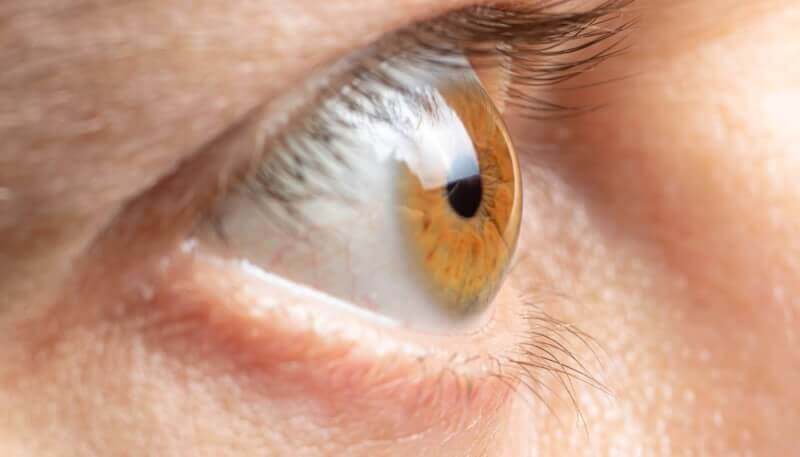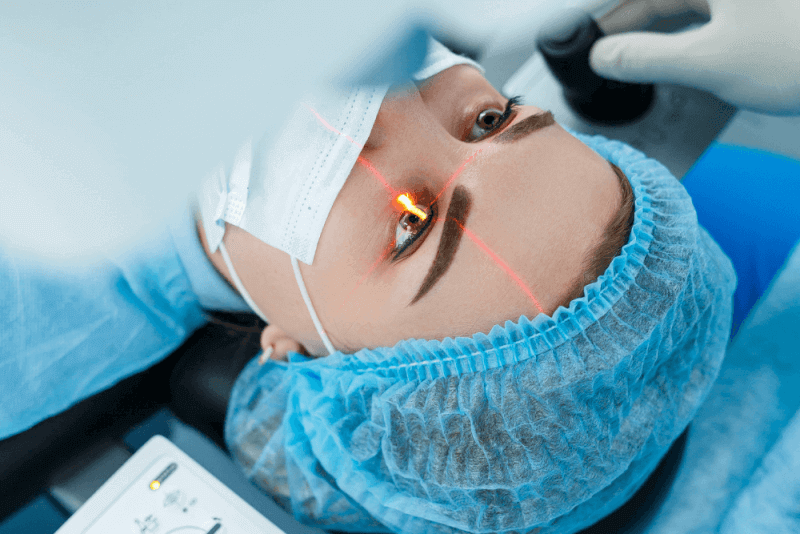What is Glaucoma?
Glaucoma is a general term used to describe a group of eye diseases that damage the optic nerves. It is the most common type of optic nerve damage resulting in vision loss. In a significant number of cases, fluid accumulates in the front part of the eye, and this accumulated fluid puts pressure on the optic nerves, causing damage over time.
This pressure is called intraocular pressure or eye pressure. On the other hand, some patients may develop glaucoma even if their eye pressure is normal.
In most patients, glaucoma develops in both eyes. However, at the early stage of the disease, one eye may be worse. In patients, one eye may show moderate to severe damage, while the other eye may show only mild damage. People with closed-angle glaucoma in one eye have a 40% to 80% chance of developing glaucoma in the other eye within 5 to 10 years.
Causes of Glaucoma
Glaucoma can develop without any apparent cause, but many factors contribute to its occurrence. The main factor is an increase in intraocular pressure. The eyes produce a fluid that nourishes them, and this fluid flows from the pupil to the front of the eye.
In a healthy eye, this fluid is expelled through a drainage channel between the iris and the cornea. In patients with glaucoma, resistance in the drainage channels increases. As a result, excess fluid has nowhere to go and continues to accumulate in the eye. This accumulation puts pressure on the eye and eventually raises eye pressure. The increased eye pressure can damage the optic nerve, leading to glaucoma.
Symptoms of Glaucoma
It is important to recognize the early symptoms of glaucoma to prevent vision loss. However, some types of glaucoma do not give any early warning signs, and vision changes occur gradually.
Therefore, it is very easy to overlook symptoms in some types. Open-angle glaucoma usually has no noticeable symptoms in many people. Therefore, regular eye examinations are crucial for diagnosing the disease, as the damage caused by glaucoma is irreversible.
Closed-angle glaucoma tends to occur suddenly and presents with more severe symptoms. Symptoms that may be seen in all types of glaucoma include the following:
- Eye pain
- Pressure in the eye
- Headache
- Rainbow halos around lights
- Low vision
- Blurred vision
- Tunnel vision
- Blind spots
- Nausea
- Vomiting
- Redness of the eyes
Diagnosis of Glaucoma
Since glaucoma does not always show symptoms, it is not always possible to know if it is present. Therefore, regular eye examinations are extremely important. Eye examinations can evaluate optic health and assess vision loss.
To understand glaucoma, an eye doctor may perform one or more of the following tests. These tests do not cause pain or discomfort for patients:
- Dilated eye examination to widen the pupils and view the optic nerve at the back of the eye
- Gonioscopy to examine the angle where the iris meets the cornea
- OCT test to look for changes in the optic nerve
- Pachymetry to measure corneal thickness
- Slit-lamp examination
- Visual acuity test
- Visual field test to check for changes in peripheral vision
Treatment Methods for Glaucoma
If glaucoma is left untreated, the progression of permanent vision loss can be rapid. The treatment methods used in glaucoma do not completely cure the condition but help slow the progression of vision loss.
Medication
Various eye drops are used in the treatment of glaucoma. Some of these drops reduce fluid production and increase drainage to improve eye pressure. Since glaucoma is a chronic disease, the prescribed eye drops must be used daily for life.
Additionally, a newly approved implant that delivers medication gradually over several months with a single application has also started to be used. This implant is placed in each eye only once and releases bimatoprost in set doses.
Laser Treatment
Laser treatment is used to help improve fluid drainage. It can be recommended as a first-line treatment. However, laser treatment may not completely replace the use of eye drops. While the results of the treatment vary, some patients may experience positive results for years. Some types of laser treatments may be repeated if necessary.
Glaucoma Surgery
Another treatment method that helps reduce intraocular pressure is surgery. Although a more invasive method, it can control eye pressure more quickly than eye drops or laser treatment. Surgical methods can help slow down vision loss but cannot restore lost vision or cure glaucoma.
Types of Glaucoma Surgery
There are many surgical procedures used in the treatment of glaucoma. The type of surgery will be selected based on the specific type and severity of the glaucoma.
Trabeculectomy
This method, typically used to treat open-angle glaucoma, takes less than an hour. To perform this method, the surgeon first creates a small incision in the upper part of the eye. The incision is made in a location under the eyelid, where it is not visible from the outside. Through this incision, excess fluid is drained, and intraocular pressure is reduced.
This procedure is usually performed under local anesthesia. Patients can be discharged on the same day after surgery, but they will need someone to help them get home.
Glaucoma Implant Surgery
Glaucoma implant surgeries are used to treat various types of glaucoma, including congenital glaucoma, neovascular glaucoma, and glaucoma caused by injuries. In these surgeries, which last between 1 and 2 hours, surgeons place a small tube or shunt in the white part of the eye. This tube helps drain excess fluid from the eye, reducing eye pressure. Patients can be discharged on the same day after the surgery, which is performed under local anesthesia.
Minimally Invasive Glaucoma Surgery (MIGS)
This new approach is recommended for patients with mild glaucoma. It is preferred because it reduces intraocular pressure with less risk and fewer side effects. In addition, patients recover faster after this procedure. Therefore, it is important to discuss with a doctor to determine the most appropriate procedure.
Benefits of Glaucoma Surgery
The effects of glaucoma surgeries are seen quickly. They significantly reduce the risk of complications caused by the disease. These surgeries offer more effective results in the long term.
Complications of Glaucoma Surgery
Complications of glaucoma surgery include the following:
- Eye swelling
- Pain
- Cataracts
- Corneal problems
- Decreased eye pressure
- Vision loss
Life After Glaucoma Surgery
After glaucoma surgery, various eye drops are prescribed to prevent swelling and infections. These medications need to be used for several weeks. Additionally, during the recovery period, heavy lifting should be avoided for 2 to 4 weeks. It is essential to attend follow-up appointments with the doctor to ensure that the eye is healing well.
Risk Factors for Glaucoma
Glaucoma is a disease that can affect people of all ages and genders, but the risk increases with age. Especially Black and Hispanic individuals have a higher chance of developing glaucoma compared to other ethnic groups, and it tends to occur at a younger age in these groups.
Asian individuals are also more susceptible to the form known as closed-angle glaucoma. People with diabetes are twice as likely to develop glaucoma compared to the general population. Other risk factors for glaucoma include the following:
- Family history of glaucoma
- Farsightedness or hyperopia
- Hypertension
- Long-term use of corticosteroids
- Myopia
- Eye injuries
- Eye surgeries
Types of Glaucoma
There are many subtypes of glaucoma. The most common ones include the following:
Open-Angle Glaucoma
The most common type of glaucoma, open-angle glaucoma, occurs when there is resistance in the drainage channels of the eye. Because many patients do not show symptoms, the disease can continue unnoticed for years.
Closed-Angle Glaucoma
Also known as angle-closure or narrow-angle glaucoma, this type is rare and occurs suddenly. Closed-angle glaucoma, seen when the angle between the iris and cornea is too narrow, can also occur when the pupil changes and dilates too quickly. This blocks the drainage channels, preventing fluid from leaving the eye. It can cause severe symptoms such as eye pain and headache and requires urgent medical attention.
Normal-Tension Glaucoma
Normal-tension glaucoma refers to a condition where optic nerve damage occurs despite normal eye pressure. The exact cause of normal-tension glaucoma is not yet known, and it is more common in people of Asian descent.
Congenital (Pediatric) Glaucoma
Some babies are born with improperly formed drainage channels in the womb. In this type, glaucoma symptoms are usually noticeable at birth or may not be detected until childhood. Other names for this type include infantile or pediatric glaucoma.
Prevention of Glaucoma
There are no known ways to prevent glaucoma. However, early diagnosis can reduce the likelihood of vision loss. People with the following conditions are particularly advised to undergo regular glaucoma testing:
- 1 to 3 years after age 35 for those at high risk
- 1 to 3 years between the ages of 40 and 54
- 1 to 2 years between the ages of 55 and 64
- Every 6 months to 1 year after age 65







